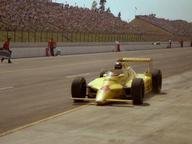Quiz Answer Key and Fun Facts
1. Jean Behra was one of the Grand Prix stars in the 1950s, flying the flag for France. But despite numerous successes in non-Championship races, he did not win a Chmapionship race. How many times was he on the podium without taking that elusive win?
2. Eugenio Castellotti was seen as the man to inherit Alberto Ascari's mantle after his death in 1955. Where did Castellotti finish in the 1955 Drivers Championship?
3. Chris Amon is often regarded as one of the unluckiest drivers of all times as he finished on the podium 11 times without actually winning a race. In Championship terms, his best finish was fourth overall. In which year did he finish fourth?
4. Mike Parkes only raced in six Grand Prix in 1966-67 but finished second in 1966 driving for who?
5. Piers Courage was another of the young British breed breaking through into Formula One during the 1960s. Who did he race for in the 1969 Formula One season?
6. Jean-Pierre Jarier was one of a number of young French drivers breaking through into Formula One in the 1970s. He came closest to winning a race at the 1978 Canadian Grand Prix driving for which constructor?
7. Andrea de Cesaris had a long career in Formula One of over 200 starts. Never to win a race, he did finish second twice for which constructor in 1983?
8. Derek Warwick scored four podiums in his career and all of them came in one season. Which year?
9. Martin Brundle had to wait a long time for a competitive car after his debut for Tyrrell in 1984. A finish of second at Detroit was wiped due to a technical infringement. His first recognised podium was in which year?
10. Mika Salo spent the majority of his Formula One career in less than stellar machinery. But a six race stint for Ferrari in 1999 led to a second place finish at which Grand Prix?
Source: Author
minardifan
This quiz was reviewed by FunTrivia editor
gtho4 before going online.
Any errors found in FunTrivia content are routinely corrected through our feedback system.
